Exploring Stigma in Mental Illness and Anti-Stigma Campaigns
VerifiedAdded on 2020/02/03
|5
|1658
|43
Essay
AI Summary
This essay examines the concept of stigma in mental illness, exploring how it leads to disgrace, isolation, and discrimination. It delves into the impact of stigma on individuals with conditions like depression and anxiety, as well as on their family members, highlighting feelings of shame, hopelessness, and social exclusion. The essay discusses different forms of stigma, including physical and group association stigmas, and analyzes how stigma affects treatment adherence and employment. Furthermore, it explores mental health promotion through anti-stigma campaigns, focusing on websites like Time to Change and Livestrong, which aim to raise awareness and combat misperceptions. The essay emphasizes the importance of removing stigma to improve the lives of those affected by mental illness and their families.
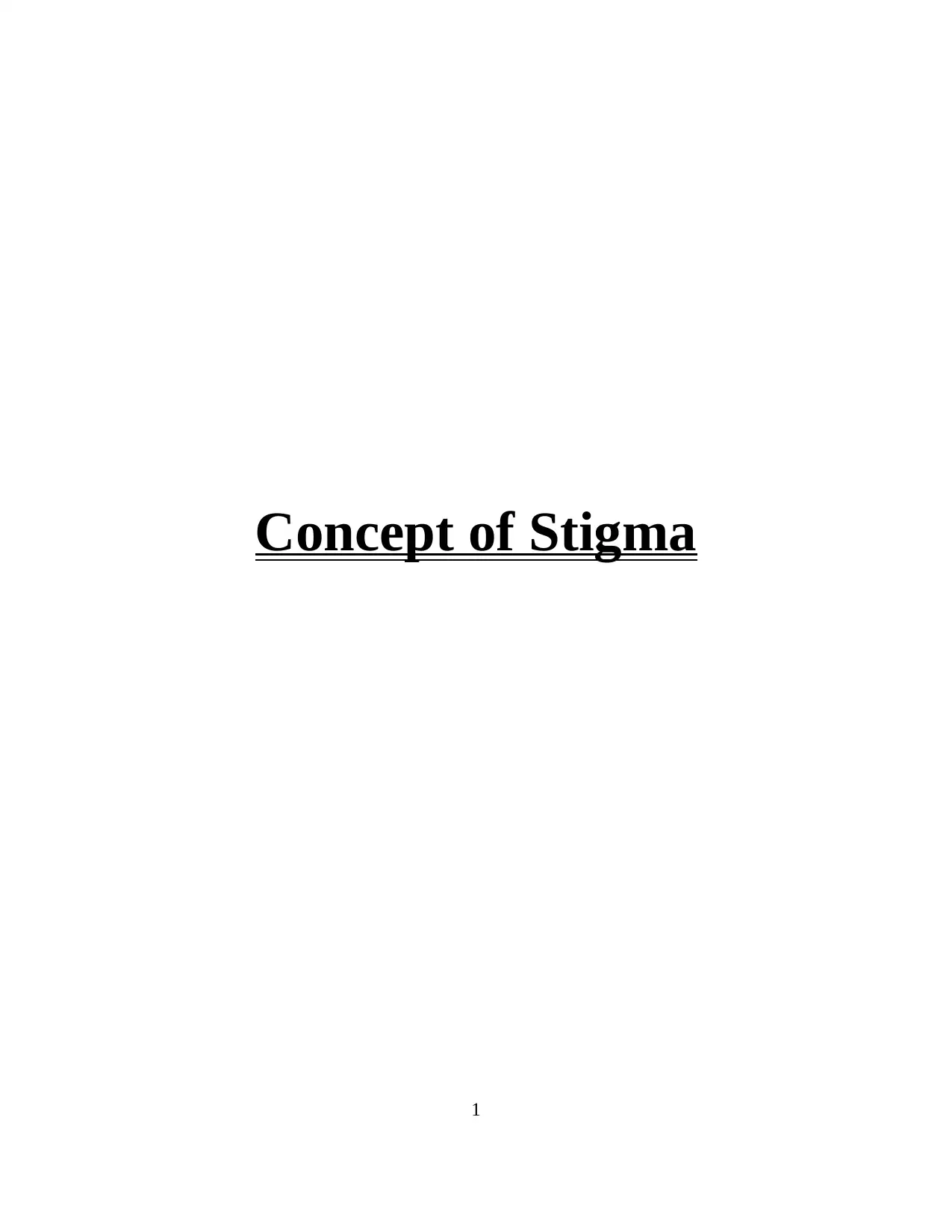
Concept of Stigma
1
1
Paraphrase This Document
Need a fresh take? Get an instant paraphrase of this document with our AI Paraphraser
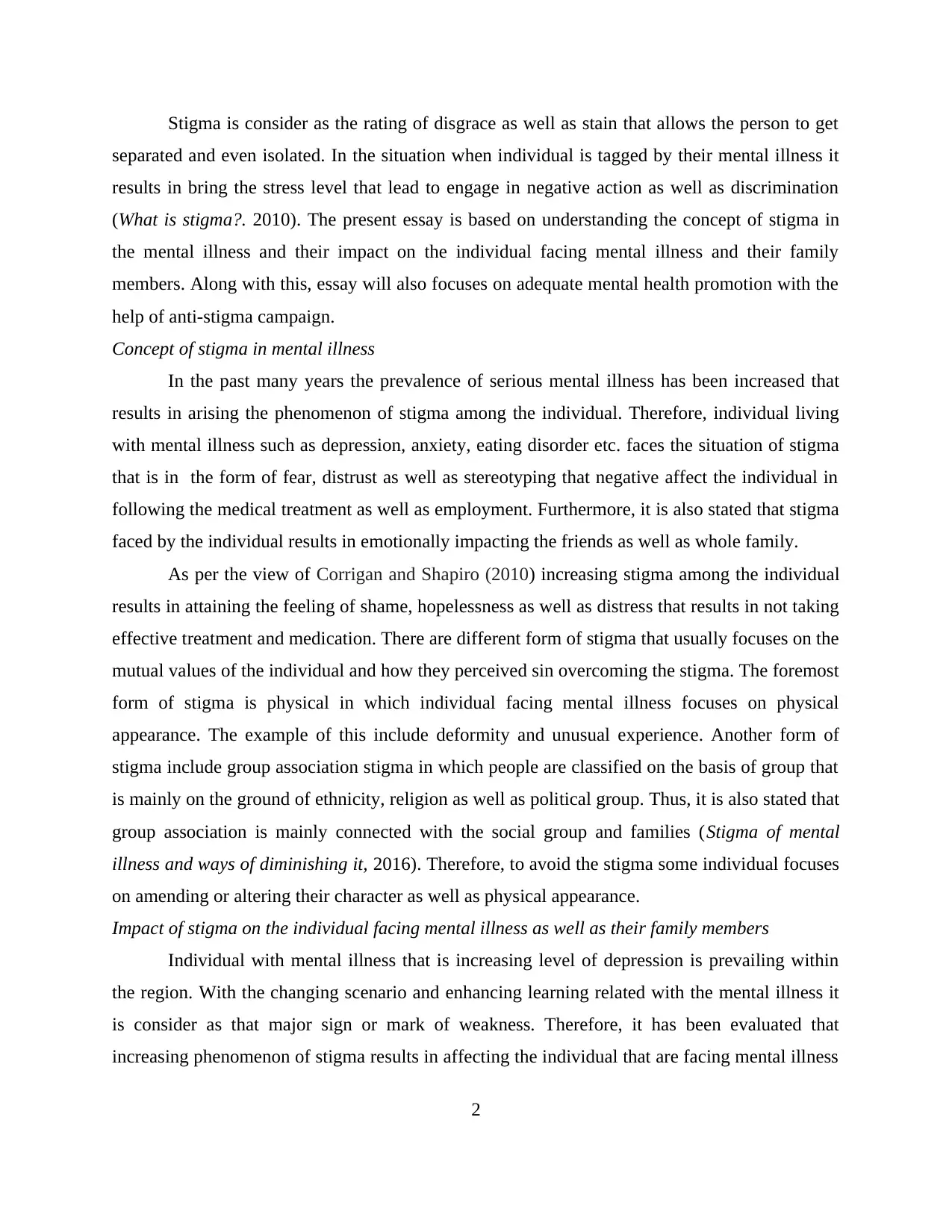
Stigma is consider as the rating of disgrace as well as stain that allows the person to get
separated and even isolated. In the situation when individual is tagged by their mental illness it
results in bring the stress level that lead to engage in negative action as well as discrimination
(What is stigma?. 2010). The present essay is based on understanding the concept of stigma in
the mental illness and their impact on the individual facing mental illness and their family
members. Along with this, essay will also focuses on adequate mental health promotion with the
help of anti-stigma campaign.
Concept of stigma in mental illness
In the past many years the prevalence of serious mental illness has been increased that
results in arising the phenomenon of stigma among the individual. Therefore, individual living
with mental illness such as depression, anxiety, eating disorder etc. faces the situation of stigma
that is in the form of fear, distrust as well as stereotyping that negative affect the individual in
following the medical treatment as well as employment. Furthermore, it is also stated that stigma
faced by the individual results in emotionally impacting the friends as well as whole family.
As per the view of Corrigan and Shapiro (2010) increasing stigma among the individual
results in attaining the feeling of shame, hopelessness as well as distress that results in not taking
effective treatment and medication. There are different form of stigma that usually focuses on the
mutual values of the individual and how they perceived sin overcoming the stigma. The foremost
form of stigma is physical in which individual facing mental illness focuses on physical
appearance. The example of this include deformity and unusual experience. Another form of
stigma include group association stigma in which people are classified on the basis of group that
is mainly on the ground of ethnicity, religion as well as political group. Thus, it is also stated that
group association is mainly connected with the social group and families (Stigma of mental
illness and ways of diminishing it, 2016). Therefore, to avoid the stigma some individual focuses
on amending or altering their character as well as physical appearance.
Impact of stigma on the individual facing mental illness as well as their family members
Individual with mental illness that is increasing level of depression is prevailing within
the region. With the changing scenario and enhancing learning related with the mental illness it
is consider as that major sign or mark of weakness. Therefore, it has been evaluated that
increasing phenomenon of stigma results in affecting the individual that are facing mental illness
2
separated and even isolated. In the situation when individual is tagged by their mental illness it
results in bring the stress level that lead to engage in negative action as well as discrimination
(What is stigma?. 2010). The present essay is based on understanding the concept of stigma in
the mental illness and their impact on the individual facing mental illness and their family
members. Along with this, essay will also focuses on adequate mental health promotion with the
help of anti-stigma campaign.
Concept of stigma in mental illness
In the past many years the prevalence of serious mental illness has been increased that
results in arising the phenomenon of stigma among the individual. Therefore, individual living
with mental illness such as depression, anxiety, eating disorder etc. faces the situation of stigma
that is in the form of fear, distrust as well as stereotyping that negative affect the individual in
following the medical treatment as well as employment. Furthermore, it is also stated that stigma
faced by the individual results in emotionally impacting the friends as well as whole family.
As per the view of Corrigan and Shapiro (2010) increasing stigma among the individual
results in attaining the feeling of shame, hopelessness as well as distress that results in not taking
effective treatment and medication. There are different form of stigma that usually focuses on the
mutual values of the individual and how they perceived sin overcoming the stigma. The foremost
form of stigma is physical in which individual facing mental illness focuses on physical
appearance. The example of this include deformity and unusual experience. Another form of
stigma include group association stigma in which people are classified on the basis of group that
is mainly on the ground of ethnicity, religion as well as political group. Thus, it is also stated that
group association is mainly connected with the social group and families (Stigma of mental
illness and ways of diminishing it, 2016). Therefore, to avoid the stigma some individual focuses
on amending or altering their character as well as physical appearance.
Impact of stigma on the individual facing mental illness as well as their family members
Individual with mental illness that is increasing level of depression is prevailing within
the region. With the changing scenario and enhancing learning related with the mental illness it
is consider as that major sign or mark of weakness. Therefore, it has been evaluated that
increasing phenomenon of stigma results in affecting the individual that are facing mental illness
2
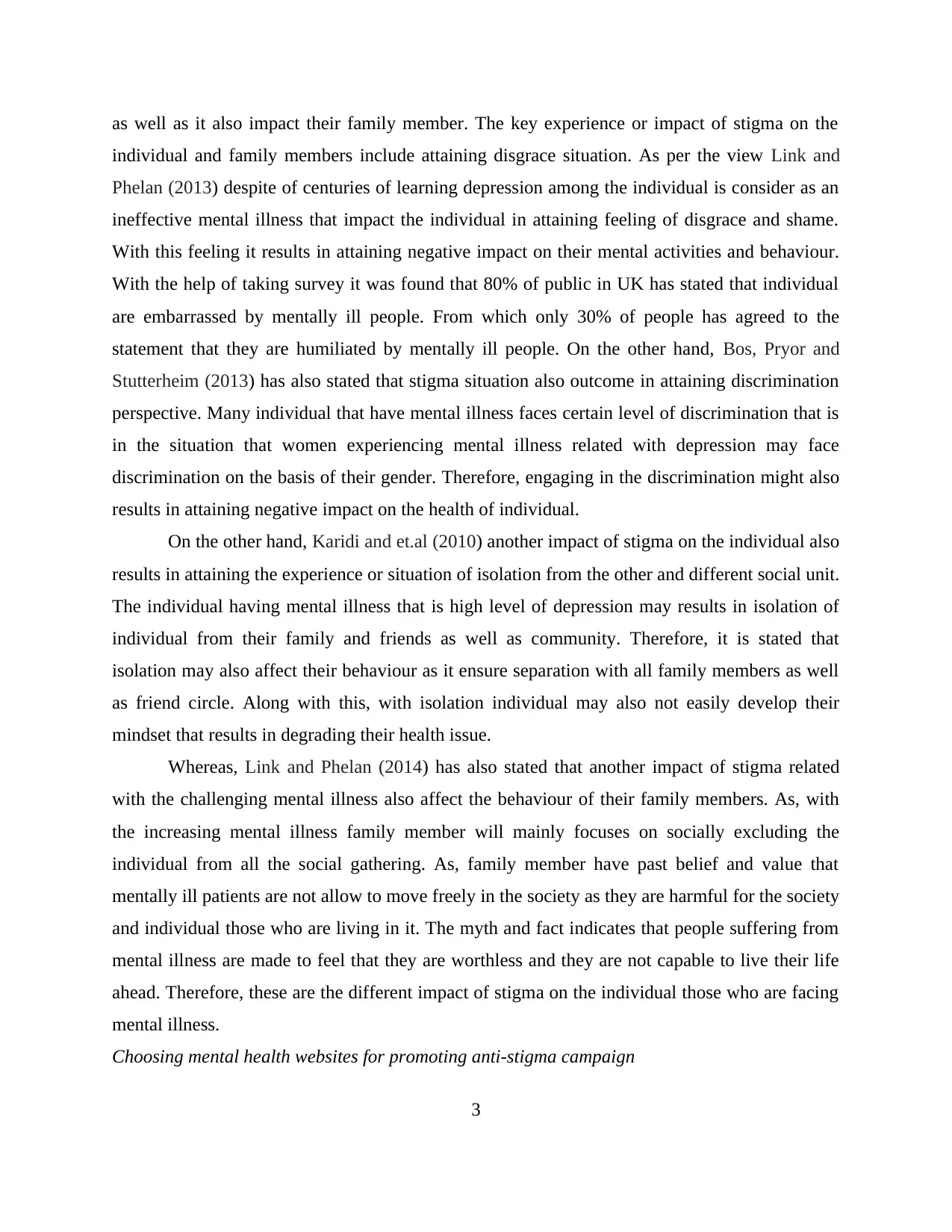
as well as it also impact their family member. The key experience or impact of stigma on the
individual and family members include attaining disgrace situation. As per the view Link and
Phelan (2013) despite of centuries of learning depression among the individual is consider as an
ineffective mental illness that impact the individual in attaining feeling of disgrace and shame.
With this feeling it results in attaining negative impact on their mental activities and behaviour.
With the help of taking survey it was found that 80% of public in UK has stated that individual
are embarrassed by mentally ill people. From which only 30% of people has agreed to the
statement that they are humiliated by mentally ill people. On the other hand, Bos, Pryor and
Stutterheim (2013) has also stated that stigma situation also outcome in attaining discrimination
perspective. Many individual that have mental illness faces certain level of discrimination that is
in the situation that women experiencing mental illness related with depression may face
discrimination on the basis of their gender. Therefore, engaging in the discrimination might also
results in attaining negative impact on the health of individual.
On the other hand, Karidi and et.al (2010) another impact of stigma on the individual also
results in attaining the experience or situation of isolation from the other and different social unit.
The individual having mental illness that is high level of depression may results in isolation of
individual from their family and friends as well as community. Therefore, it is stated that
isolation may also affect their behaviour as it ensure separation with all family members as well
as friend circle. Along with this, with isolation individual may also not easily develop their
mindset that results in degrading their health issue.
Whereas, Link and Phelan (2014) has also stated that another impact of stigma related
with the challenging mental illness also affect the behaviour of their family members. As, with
the increasing mental illness family member will mainly focuses on socially excluding the
individual from all the social gathering. As, family member have past belief and value that
mentally ill patients are not allow to move freely in the society as they are harmful for the society
and individual those who are living in it. The myth and fact indicates that people suffering from
mental illness are made to feel that they are worthless and they are not capable to live their life
ahead. Therefore, these are the different impact of stigma on the individual those who are facing
mental illness.
Choosing mental health websites for promoting anti-stigma campaign
3
individual and family members include attaining disgrace situation. As per the view Link and
Phelan (2013) despite of centuries of learning depression among the individual is consider as an
ineffective mental illness that impact the individual in attaining feeling of disgrace and shame.
With this feeling it results in attaining negative impact on their mental activities and behaviour.
With the help of taking survey it was found that 80% of public in UK has stated that individual
are embarrassed by mentally ill people. From which only 30% of people has agreed to the
statement that they are humiliated by mentally ill people. On the other hand, Bos, Pryor and
Stutterheim (2013) has also stated that stigma situation also outcome in attaining discrimination
perspective. Many individual that have mental illness faces certain level of discrimination that is
in the situation that women experiencing mental illness related with depression may face
discrimination on the basis of their gender. Therefore, engaging in the discrimination might also
results in attaining negative impact on the health of individual.
On the other hand, Karidi and et.al (2010) another impact of stigma on the individual also
results in attaining the experience or situation of isolation from the other and different social unit.
The individual having mental illness that is high level of depression may results in isolation of
individual from their family and friends as well as community. Therefore, it is stated that
isolation may also affect their behaviour as it ensure separation with all family members as well
as friend circle. Along with this, with isolation individual may also not easily develop their
mindset that results in degrading their health issue.
Whereas, Link and Phelan (2014) has also stated that another impact of stigma related
with the challenging mental illness also affect the behaviour of their family members. As, with
the increasing mental illness family member will mainly focuses on socially excluding the
individual from all the social gathering. As, family member have past belief and value that
mentally ill patients are not allow to move freely in the society as they are harmful for the society
and individual those who are living in it. The myth and fact indicates that people suffering from
mental illness are made to feel that they are worthless and they are not capable to live their life
ahead. Therefore, these are the different impact of stigma on the individual those who are facing
mental illness.
Choosing mental health websites for promoting anti-stigma campaign
3
⊘ This is a preview!⊘
Do you want full access?
Subscribe today to unlock all pages.

Trusted by 1+ million students worldwide
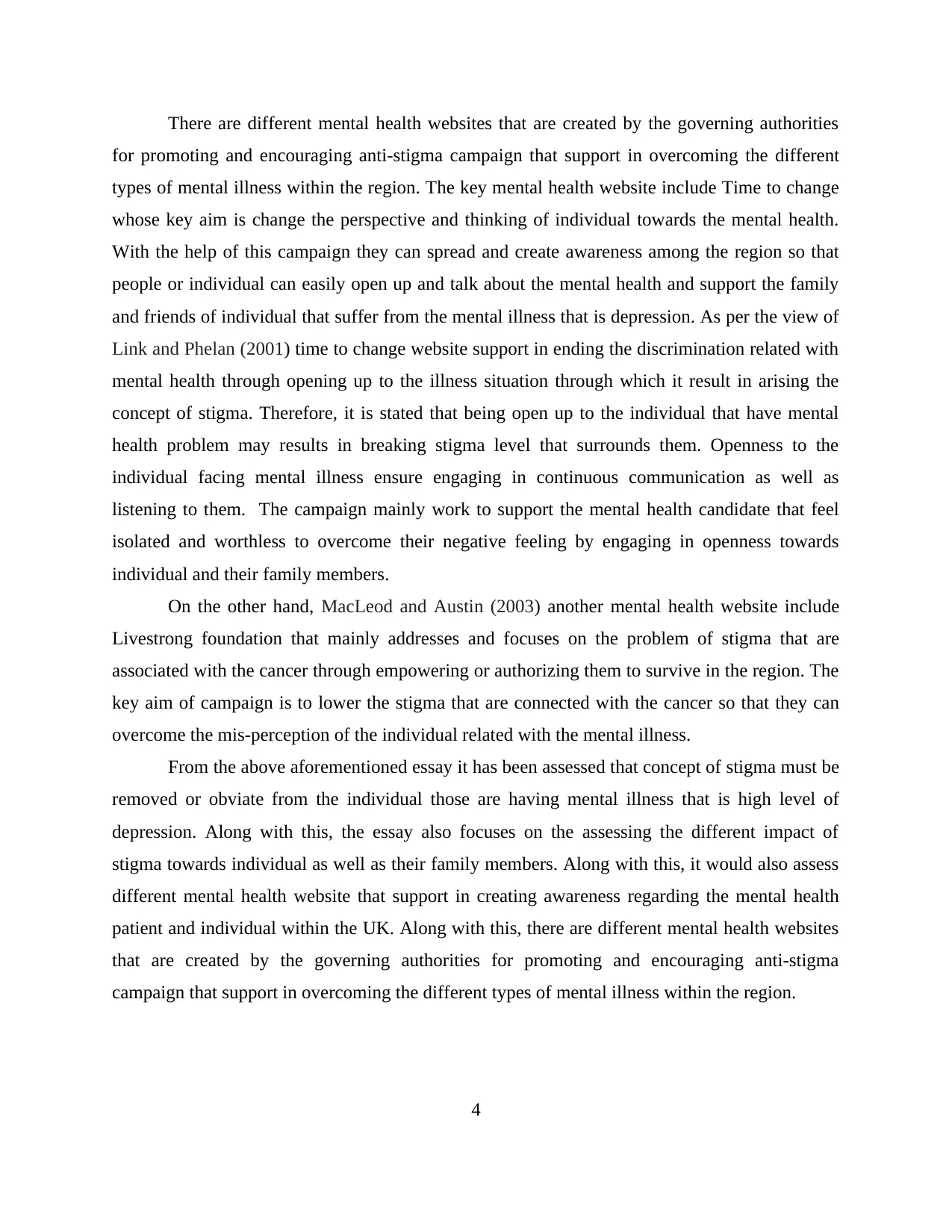
There are different mental health websites that are created by the governing authorities
for promoting and encouraging anti-stigma campaign that support in overcoming the different
types of mental illness within the region. The key mental health website include Time to change
whose key aim is change the perspective and thinking of individual towards the mental health.
With the help of this campaign they can spread and create awareness among the region so that
people or individual can easily open up and talk about the mental health and support the family
and friends of individual that suffer from the mental illness that is depression. As per the view of
Link and Phelan (2001) time to change website support in ending the discrimination related with
mental health through opening up to the illness situation through which it result in arising the
concept of stigma. Therefore, it is stated that being open up to the individual that have mental
health problem may results in breaking stigma level that surrounds them. Openness to the
individual facing mental illness ensure engaging in continuous communication as well as
listening to them. The campaign mainly work to support the mental health candidate that feel
isolated and worthless to overcome their negative feeling by engaging in openness towards
individual and their family members.
On the other hand, MacLeod and Austin (2003) another mental health website include
Livestrong foundation that mainly addresses and focuses on the problem of stigma that are
associated with the cancer through empowering or authorizing them to survive in the region. The
key aim of campaign is to lower the stigma that are connected with the cancer so that they can
overcome the mis-perception of the individual related with the mental illness.
From the above aforementioned essay it has been assessed that concept of stigma must be
removed or obviate from the individual those are having mental illness that is high level of
depression. Along with this, the essay also focuses on the assessing the different impact of
stigma towards individual as well as their family members. Along with this, it would also assess
different mental health website that support in creating awareness regarding the mental health
patient and individual within the UK. Along with this, there are different mental health websites
that are created by the governing authorities for promoting and encouraging anti-stigma
campaign that support in overcoming the different types of mental illness within the region.
4
for promoting and encouraging anti-stigma campaign that support in overcoming the different
types of mental illness within the region. The key mental health website include Time to change
whose key aim is change the perspective and thinking of individual towards the mental health.
With the help of this campaign they can spread and create awareness among the region so that
people or individual can easily open up and talk about the mental health and support the family
and friends of individual that suffer from the mental illness that is depression. As per the view of
Link and Phelan (2001) time to change website support in ending the discrimination related with
mental health through opening up to the illness situation through which it result in arising the
concept of stigma. Therefore, it is stated that being open up to the individual that have mental
health problem may results in breaking stigma level that surrounds them. Openness to the
individual facing mental illness ensure engaging in continuous communication as well as
listening to them. The campaign mainly work to support the mental health candidate that feel
isolated and worthless to overcome their negative feeling by engaging in openness towards
individual and their family members.
On the other hand, MacLeod and Austin (2003) another mental health website include
Livestrong foundation that mainly addresses and focuses on the problem of stigma that are
associated with the cancer through empowering or authorizing them to survive in the region. The
key aim of campaign is to lower the stigma that are connected with the cancer so that they can
overcome the mis-perception of the individual related with the mental illness.
From the above aforementioned essay it has been assessed that concept of stigma must be
removed or obviate from the individual those are having mental illness that is high level of
depression. Along with this, the essay also focuses on the assessing the different impact of
stigma towards individual as well as their family members. Along with this, it would also assess
different mental health website that support in creating awareness regarding the mental health
patient and individual within the UK. Along with this, there are different mental health websites
that are created by the governing authorities for promoting and encouraging anti-stigma
campaign that support in overcoming the different types of mental illness within the region.
4
Paraphrase This Document
Need a fresh take? Get an instant paraphrase of this document with our AI Paraphraser
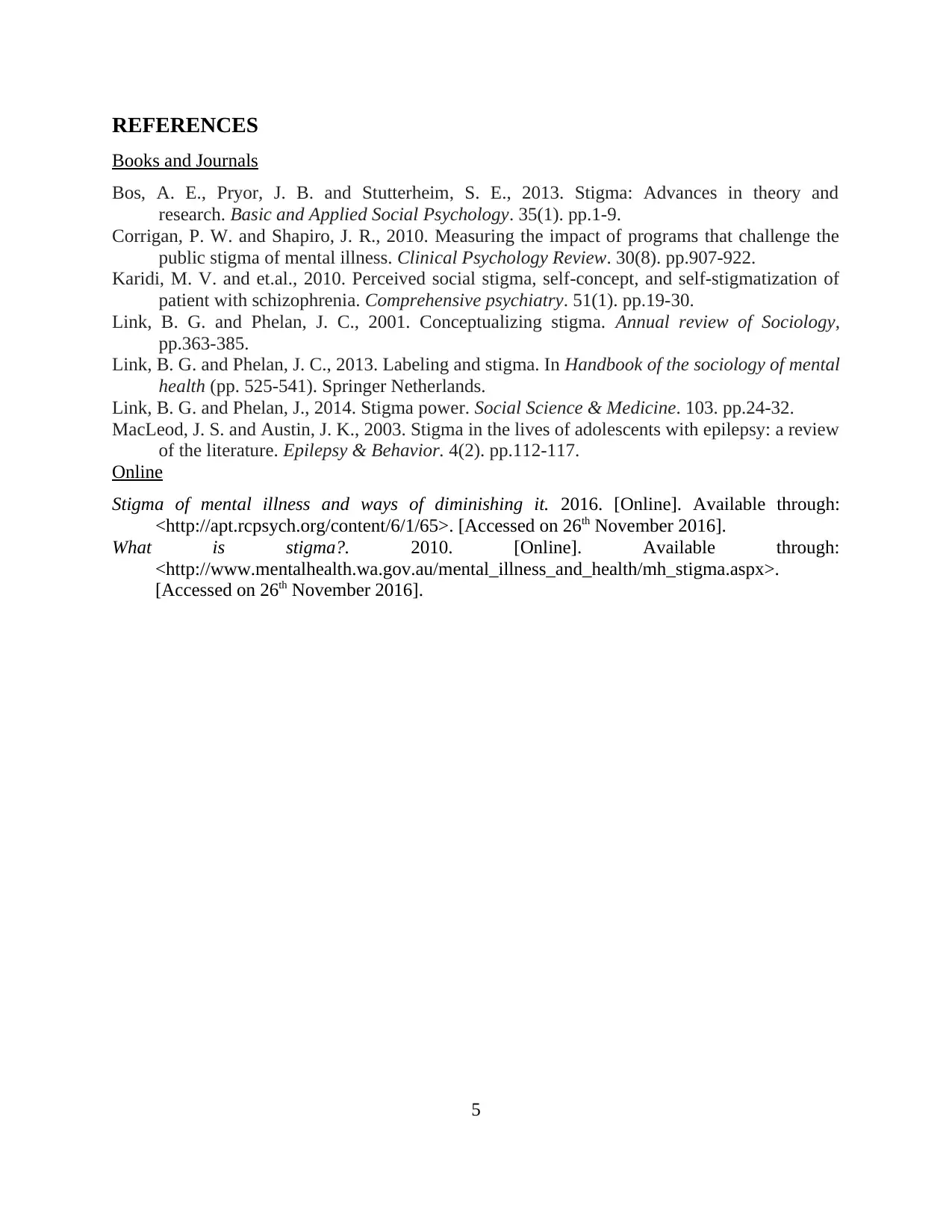
REFERENCES
Books and Journals
Bos, A. E., Pryor, J. B. and Stutterheim, S. E., 2013. Stigma: Advances in theory and
research. Basic and Applied Social Psychology. 35(1). pp.1-9.
Corrigan, P. W. and Shapiro, J. R., 2010. Measuring the impact of programs that challenge the
public stigma of mental illness. Clinical Psychology Review. 30(8). pp.907-922.
Karidi, M. V. and et.al., 2010. Perceived social stigma, self-concept, and self-stigmatization of
patient with schizophrenia. Comprehensive psychiatry. 51(1). pp.19-30.
Link, B. G. and Phelan, J. C., 2001. Conceptualizing stigma. Annual review of Sociology,
pp.363-385.
Link, B. G. and Phelan, J. C., 2013. Labeling and stigma. In Handbook of the sociology of mental
health (pp. 525-541). Springer Netherlands.
Link, B. G. and Phelan, J., 2014. Stigma power. Social Science & Medicine. 103. pp.24-32.
MacLeod, J. S. and Austin, J. K., 2003. Stigma in the lives of adolescents with epilepsy: a review
of the literature. Epilepsy & Behavior. 4(2). pp.112-117.
Online
Stigma of mental illness and ways of diminishing it. 2016. [Online]. Available through:
<http://apt.rcpsych.org/content/6/1/65>. [Accessed on 26th November 2016].
What is stigma?. 2010. [Online]. Available through:
<http://www.mentalhealth.wa.gov.au/mental_illness_and_health/mh_stigma.aspx>.
[Accessed on 26th November 2016].
5
Books and Journals
Bos, A. E., Pryor, J. B. and Stutterheim, S. E., 2013. Stigma: Advances in theory and
research. Basic and Applied Social Psychology. 35(1). pp.1-9.
Corrigan, P. W. and Shapiro, J. R., 2010. Measuring the impact of programs that challenge the
public stigma of mental illness. Clinical Psychology Review. 30(8). pp.907-922.
Karidi, M. V. and et.al., 2010. Perceived social stigma, self-concept, and self-stigmatization of
patient with schizophrenia. Comprehensive psychiatry. 51(1). pp.19-30.
Link, B. G. and Phelan, J. C., 2001. Conceptualizing stigma. Annual review of Sociology,
pp.363-385.
Link, B. G. and Phelan, J. C., 2013. Labeling and stigma. In Handbook of the sociology of mental
health (pp. 525-541). Springer Netherlands.
Link, B. G. and Phelan, J., 2014. Stigma power. Social Science & Medicine. 103. pp.24-32.
MacLeod, J. S. and Austin, J. K., 2003. Stigma in the lives of adolescents with epilepsy: a review
of the literature. Epilepsy & Behavior. 4(2). pp.112-117.
Online
Stigma of mental illness and ways of diminishing it. 2016. [Online]. Available through:
<http://apt.rcpsych.org/content/6/1/65>. [Accessed on 26th November 2016].
What is stigma?. 2010. [Online]. Available through:
<http://www.mentalhealth.wa.gov.au/mental_illness_and_health/mh_stigma.aspx>.
[Accessed on 26th November 2016].
5
1 out of 5
Related Documents
Your All-in-One AI-Powered Toolkit for Academic Success.
+13062052269
info@desklib.com
Available 24*7 on WhatsApp / Email
![[object Object]](/_next/static/media/star-bottom.7253800d.svg)
Unlock your academic potential
Copyright © 2020–2025 A2Z Services. All Rights Reserved. Developed and managed by ZUCOL.





